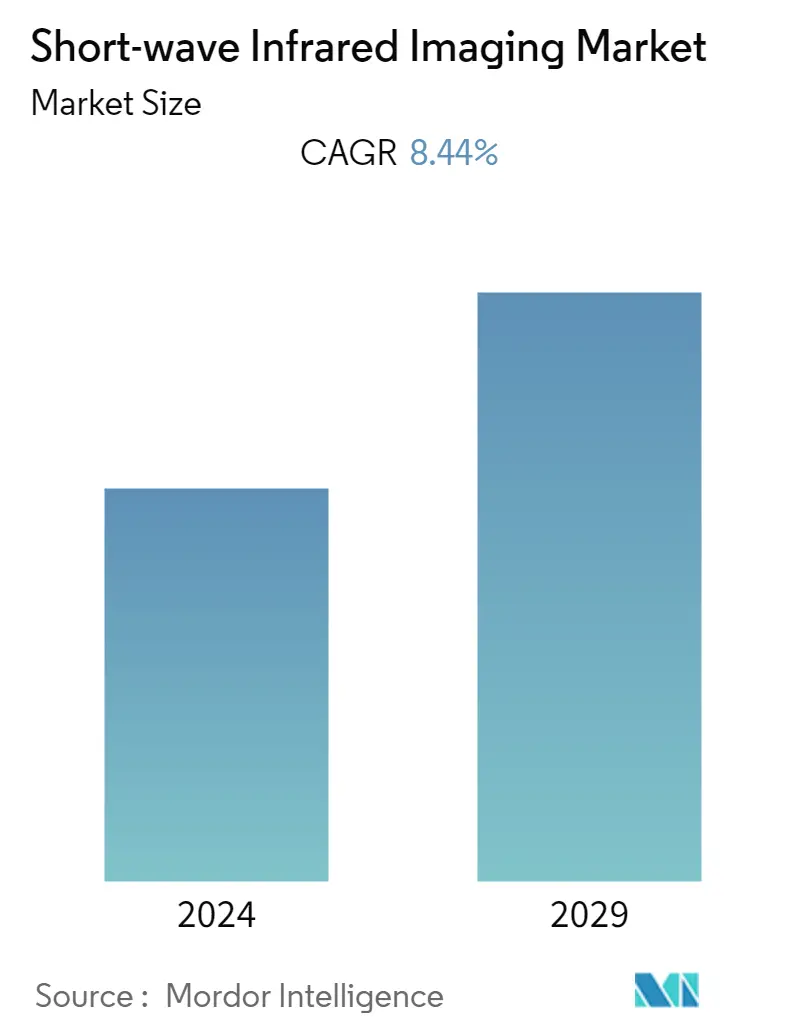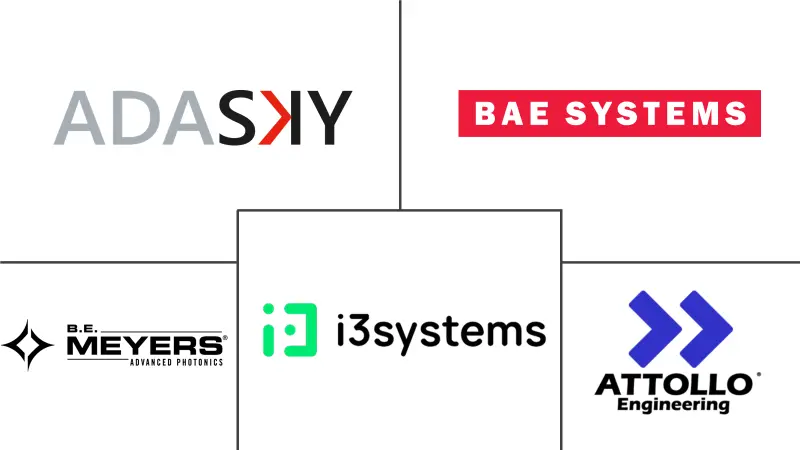Market Size of Short-wave Infrared Imaging Industry

| Study Period | 2019 - 2029 |
| Base Year For Estimation | 2023 |
| CAGR | 8.44 % |
| Fastest Growing Market | Asia-Pacific |
| Largest Market | North America |
| Market Concentration | Low |
Major Players
*Disclaimer: Major Players sorted in no particular order |
Short-wave Infrared Imaging Market Analysis
The Short-wave Infrared Imaging Market is expected to grow at a CAGR of 8.44% during the forecast period, 2022-2027. With the recent outbreak of COVID-19, there has been a global disruption in the supply chain. The COVID-19 outbreak has disrupted the global tech sector, especially hardware, electronic manufacturing services providers, and semiconductor companies, as operations in the global largest tech manufacturing hub are threatened.
- Short-wave infrared imaging (SWIR) is an advanced technique for producing images based on radiation in the region of the electromagnetic spectrum, which is invisible to the naked eye. Short-wave infrared (SWIR) imaging is distinct because the radiation of interest is nearer to the visible spectrum but will still permit temperature sensing, usually over 100 °C.
- Short-wave infrared (SWIR) imaging consists of a wavelength band from 0.7 - 2.5μm. SWIR imaging is used in various applications, including solar cell inspection, electronic board inspection, identification and sorting, surveillance, anti-counterfeiting, process quality control, etc.
- Vehicle navigation is increasingly relying on SWIR cameras. With the rise of self-driving cars, SWIR technology can assist in navigating through fog, snow, dust, and rain. Recently, Israeli start-up TriEye introduced a dashboard-mounted SWIR camera for the consumer car market that can successfully navigate through snow, fog, dust, and rain, responding to the expanding use of SWIR cameras in autonomous vehicles.
- A lot of investments are going on around the globe to develop short-wave infrared imaging technology. For instance, in January 2022, Emberion, a developer of high-performance short-wave infrared imaging using nanomaterials, raised EUR 6 million to accelerate infrared imaging business growth.
- Recently, Israeli start-up TriEye introduced a dashboard-mounted SWIR camera for the consumer car market that can successfully navigate through snow, fog, dust, and rain, responding to the expanding use of SWIR cameras in autonomous vehicles. According to a NASDAQ, driverless automobiles will likely dominate the market by 2030. Thus, these investments are also likely to create a scope for the market studied in this sector.
- Due to ongoing testing, research, and collaborations between companies to develop autonomous cars, the number of autonomous vehicles is anticipated to grow robustly in the upcoming years. For instance, French autonomous vehicle maker, Navya introduced an all-electric and fully autonomous Autonom Cab, the first 100% autonomous robot taxi. Another company, Valeo, partnered with Docomo to jointly develop connected cars.
Short-wave Infrared Imaging Industry Segmentation
The market study analyses the market trends and opportunities for different types of short-wave infrared imaging, such as 1 micron, 1.7 micron, and 2.1 micron, that are used in the various end-user industries in multiple regions. Further, the study analyzes the impact of COVID-19 on the market players and its stakeholders across the supply chain. Additionally, the disruption factors impacting the market's growth in the near future have been covered in the study regarding drivers and restraints.
| By Wavelength | |
| 1 micron | |
| 1.7 micron | |
| 2.1 micron |
| By Type of Sensors | |
| Line detectors | |
| Imagers |
| By Level of Integration | |
| Imagers/ Line detectors | |
| Cameras/Systems |
| By End-User Industries | |
| Military & Defense | |
| Healthcare & Research | |
| Automotive | |
| Other End-user Industries |
| By Geography | |
| North America | |
| Asia Pacific | |
| Europe | |
| Latin America | |
| Middle East and Africa |
Short-wave Infrared Imaging Market Size Summary
The Short-wave Infrared Imaging Market is poised for significant growth, driven by its applications across various sectors such as defense, automotive, and industrial automation. SWIR imaging, which operates in the wavelength band of 0.7 to 2.5μm, is increasingly utilized for its ability to provide high-resolution imaging in low-light conditions and through obstructions like fog and smoke. This technology is gaining traction in the defense sector for surveillance and reconnaissance purposes, as well as in the automotive industry for enhancing navigation systems in autonomous vehicles. The market is characterized by substantial investments and technological advancements, with companies like Emberion and TriEye leading initiatives to expand SWIR applications in machine vision and driver assistance systems.
The competitive landscape of the Short-wave Infrared Imaging Market is marked by the presence of both local and international players, with key companies such as BAE Systems, B.E Meyers & Co., and Attollo Engineering actively participating. The market is expected to expand further as more players enter, driven by the increasing demand for advanced imaging solutions. Recent developments include significant funding rounds and collaborations aimed at enhancing SWIR technology capabilities. For instance, TriEye's partnership with Hitachi Astemo focuses on improving ADAS for adverse weather conditions, while Emberion's funding supports the development of VIS-SWIR cameras. These advancements underscore the market's potential for growth and innovation in the coming years.
Short-wave Infrared Imaging Market Size - Table of Contents
-
1. MARKET INSIGHTS
-
1.1 Market Overview
-
1.2 Industry Attractiveness - Porter's Five Forces Analysis
-
1.2.1 Bargaining Power Of Suppliers
-
1.2.2 Bargaining Power Of Buyers
-
1.2.3 Threat Of New Entrants
-
1.2.4 Threat Of Substitutes
-
1.2.5 Intensity Of Competitive Rivalry
-
-
1.3 Industry Value Chain Analysis
-
1.4 Impact of Covid-19 on the market
-
-
2. MARKET SEGMENTATION
-
2.1 By Wavelength
-
2.1.1 1 micron
-
2.1.2 1.7 micron
-
2.1.3 2.1 micron
-
-
2.2 By Type of Sensors
-
2.2.1 Line detectors
-
2.2.2 Imagers
-
-
2.3 By Level of Integration
-
2.3.1 Imagers/ Line detectors
-
2.3.2 Cameras/Systems
-
-
2.4 By End-User Industries
-
2.4.1 Military & Defense
-
2.4.2 Healthcare & Research
-
2.4.3 Automotive
-
2.4.4 Other End-user Industries
-
-
2.5 By Geography
-
2.5.1 North America
-
2.5.2 Asia Pacific
-
2.5.3 Europe
-
2.5.4 Latin America
-
2.5.5 Middle East and Africa
-
-
Short-wave Infrared Imaging Market Size FAQs
What is the current Short-wave Infrared Imaging Market size?
The Short-wave Infrared Imaging Market is projected to register a CAGR of 8.44% during the forecast period (2024-2029)
Who are the key players in Short-wave Infrared Imaging Market?
B.E Meyers & Co., i3 system, Attollo Engineering, BAE Systems and Adasky, Ltd. are the major companies operating in the Short-wave Infrared Imaging Market.

